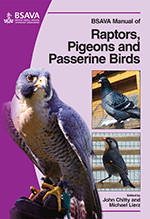
Full text loading...

Properly balanced nutrition is fundamental to the correct husbandry and performance of the captive raptor. They require a diet balanced in terms of quality, quantity and affordability that should reflect their requirements. This chapter informs the reader of nutrients, available foods, food preparation, supplements, hand-rearing and feeding in special circumstances.
Raptors: nutrition, Page 1 of 1
< Previous page | Next page > /docserver/preview/fulltext/10.22233/9781910443101/9781910443101.17-1.gif

Full text loading...








